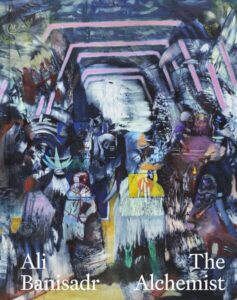Ali Banisadr: The Alchemist is a new publication and exhibition organised by the Katonah Museum of Art and the first major museum survey of Iranian-born artist Ali Banisadr. Covering twenty years of the artist’s practice, the exhibition and catalogue offer a fresh perspective on the artist’s career across the mediums of painting, drawing and printmaking.
Featured in this luxurious publication are a rich selection of works that shed light on the artist’s journey. The book features well researched essays that offer various perspectives on Banisadr’s creative process and high quality images as well as excerpts from his notebooks that chronicle the evolution of his working process.

Michelle Yun Mapplethorpe (ed) (Yale University Press, May 2025)
Born in Tehran, Banisadr was a young child during the Islamic revolution in 1979. Thereafter he was thrust into the chaos of the Iran-Iraq war that eventually took the lives of millions. Whilst living in his family’s basement shelter, he endured daily bombardments:
The bombings, the air raids; I witnessed so many ruins and chaos everywhere. When the vibrations and explosions of the air raids occurred, my mother recalls I would make drawings to try to make sense of what was happening. And I think that stays with me even now, where I still see the world as this chaotic, potentially dangerous place. Trying to make sense out of it in a visual way is the only way I can try to understand it.
Banisadr and his family migrated to Turkey and then eventually to the United States in 1988. Taking on the role of émigré at the tender age of twelve, he had to master a new language and adapt to a foreign country. Eventually, through a love of literature and artistic experimentation, he embraced Eastern and Western perspectives in his work.
These extend across geographies and chronologies and relate to disparate subjects, including magic, the ancient world, medieval and Renaissance master painters, Abstract Expressionism, Jungian psychology, Sufi poetry, and the writings of Jorge Luis Borges, Umberto Eco, and Athanasius Kircher, among many others.
In terms of working practices, his early interaction with Bay Area graffiti artists in San Francisco heavily influenced his work. He later moved to New York to attend art school which is where he further developed his practice and now works out of Brooklyn.
The publication features meticulously-researched essays, illustrated source materials, and excerpts from the artists notebooks that chronicle the fascinating evolution of Banisadr’s working methods. His works echo a multitude of references across the history of art—including Mesopotamian antiquities, alchemical imagery, Persian miniatures, Medieval and Renaissance art, Surrealism, German Expressionism, and Abstract Expressionism—as a bellwether of our own tempestuous times.
This luxury publication will interest all lovers of the syncretic nature of art and mythology.


You must be logged in to post a comment.